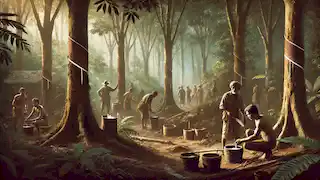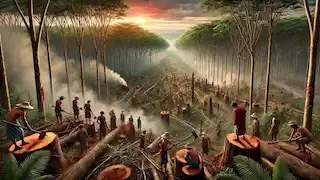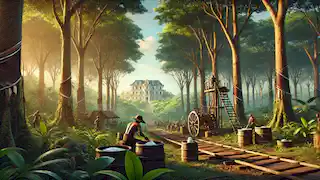In the late 19th and early 20th centuries, the Amazon rainforest became the backdrop for a ruthless and dramatic chapter in global history—the rise of the rubber barons. During this time, the world was hungry for rubber, a vital material for the burgeoning industries of the West. As tires for bicycles, cars, and machinery became essential, so too did the natural latex extracted from the rubber trees of the Amazon. This growing demand gave rise to a powerful class of entrepreneurs—known as the "rubber barons"—who exploited the rainforest's resources and enslaved its indigenous populations in the name of profit. This story delves into the dramatic and dark tale of the rubber barons, tracing their rise and fall as they transformed the Amazon into a landscape of wealth, destruction, and human suffering. The story of the rubber barons began with the realization that the Amazon was home to vast quantities of Hevea brasiliensis, the rubber tree. This tree produced the natural latex that could be turned into rubber—a material with endless possibilities in the rapidly industrializing world. For centuries, indigenous peoples had known of the properties of this tree, but it wasn’t until the 19th century that European and American entrepreneurs realized its potential for wealth. In the early days of the rubber boom, the extraction process was simple but labor-intensive. Tappers would make cuts in the bark of the rubber trees, collecting the latex in small cups. This liquid was then processed to make the rubber that would be shipped across the globe. The initial demand came from bicycle tires, but with the rise of the automobile and other machinery, the need for rubber skyrocketed. Investors flocked to the Amazon, eager to stake their claim in this new and highly profitable industry. As the demand for rubber grew, so did the fortunes of those who controlled its production. Entire towns sprang up in the jungle, fueled by the labor of indigenous peoples and migrant workers who toiled under brutal conditions. Manaus, a city deep in the heart of the Amazon, became a symbol of the wealth and extravagance of the rubber boom. Lavish opera houses, European goods, and extravagant lifestyles flourished in the midst of the dense jungle, a testament to the incredible profits being reaped from the trees. But while the rubber barons and their investors grew rich, the indigenous peoples and the Amazon itself suffered greatly. The rubber industry thrived on the backs of those forced to work in appalling conditions, often under a regime of terror and violence. In the 1880s, the demand for rubber was insatiable. As Western industries expanded, so too did their dependence on rubber, and the Amazon seemed like an endless source of wealth. At the forefront of this boom were a few men who would become known as the rubber barons—wealthy landowners and businessmen who exploited the natural resources of the rainforest and the labor of its people to build vast fortunes. One of the most infamous of these barons was Julio Cesar Arana, a Peruvian entrepreneur who built an empire by controlling large swaths of the Amazonian rubber production. Arana's methods were ruthless—he enslaved indigenous communities, forcing them to extract rubber under threat of violence and death. Those who resisted were often subjected to brutal punishments, including torture and execution. Arana's reign of terror would become one of the most infamous chapters in the history of the rubber trade. Arana was not alone. Across the Amazon, other rubber barons operated with similar brutality, controlling not only the labor force but also the vast territories where rubber trees grew. They established private armies to enforce their will, and many became de facto rulers of their own personal empires deep in the jungle. These barons often lived in opulence, enjoying luxuries imported from Europe while the workers who made their fortunes lived in abject poverty. The exploitation was not limited to indigenous people. Migrants from other parts of South America and even Europe were lured by the promise of work in the rubber industry, only to find themselves trapped in a system of debt bondage and forced labor. The harsh conditions in the Amazon, combined with the extreme demands placed on workers, led to high mortality rates, further deepening the misery of those involved in the rubber trade. Despite the brutality, the rubber barons became symbols of success in their countries, especially in places like Brazil and Peru. In cities like Manaus and Iquitos, the wealth generated from rubber transformed the urban landscape. Grand mansions, luxurious theaters, and other signs of extreme wealth stood in stark contrast to the suffering that had produced them. While the rubber barons reaped their fortunes, the Amazon rainforest and its indigenous peoples bore the brunt of the exploitation. The process of extracting rubber was devastating to the forest. Workers were forced to cut down trees, strip them of their bark, and collect the latex. This process not only damaged the trees but also led to the clearing of large swaths of forest to make way for rubber plantations. The environmental damage was immense, but the human cost was even greater. Indigenous communities that had lived in harmony with the forest for centuries were decimated. Many were forced into labor, while others were massacred or died of diseases brought by the rubber traders. The social fabric of the Amazon’s indigenous cultures was torn apart as entire tribes were enslaved or wiped out. One of the most infamous examples of this exploitation was the Putumayo affair, which exposed the horrific conditions faced by indigenous rubber workers in the region controlled by Arana's company. British and American human rights activists brought the atrocities to the world’s attention, leading to international condemnation of the rubber industry’s practices. However, little was done to improve the lives of the workers or to protect the rainforest from further exploitation. The rubber boom also contributed to the deforestation of the Amazon, as forests were cleared to make way for rubber plantations. This destruction of the rainforest had long-term consequences, not only for the environment but also for the indigenous peoples who depended on the forest for their way of life. The Amazon, once seen as an endless and indestructible resource, was slowly being destroyed by the greed of the rubber barons and the demand for rubber in the West. The reign of the rubber barons did not last forever. In the early 20th century, a new threat to their dominance emerged from an unexpected source—British scientists and entrepreneurs. In 1876, an Englishman named Henry Wickham smuggled thousands of rubber tree seeds out of the Amazon and took them to British colonies in Southeast Asia, where they were planted and cultivated. These plantations in places like Malaysia and Ceylon (modern-day Sri Lanka) proved to be much more efficient and productive than the wild rubber industry of the Amazon. The controlled environment of the plantations, combined with cheaper labor, allowed the British to produce rubber at a fraction of the cost. By the 1910s, Southeast Asian rubber had flooded the global market, and the Amazon’s dominance in the rubber trade collapsed. For the rubber barons of the Amazon, this shift was disastrous. The fortunes they had amassed were quickly depleted as demand for Amazonian rubber plummeted. The cities that had thrived on rubber, like Manaus and Iquitos, fell into decline. The grand mansions and theaters that had symbolized the wealth of the rubber barons became relics of a bygone era, as the jungle slowly reclaimed the cities that had once stood at the center of the world’s rubber trade. {{{_04}}} The fall of the rubber barons was not only an economic collapse but also a cultural one. The rubber boom had brought with it a brief period of modernization and globalization in the Amazon, as goods and people from around the world flowed into the region. With the collapse of the rubber trade, this influx came to an abrupt end, and the Amazon returned to its isolation. The story of the rubber barons is one of greed, exploitation, and environmental destruction. It is a tale of how the demand for a single product—rubber—transformed the Amazon rainforest and its people. The rubber barons built empires on the backs of the indigenous peoples they enslaved and the forests they destroyed, only to see their fortunes vanish as quickly as they had risen. Today, the legacy of the rubber boom can still be seen in the Amazon. The cities of Manaus and Iquitos, though no longer the centers of global commerce they once were, still bear the marks of their rubber baron past. The grand buildings and crumbling mansions stand as reminders of the wealth and exploitation that once defined the region. But perhaps the most lasting legacy is the damage done to the Amazon itself. The deforestation and destruction wrought by the rubber industry set a precedent for the exploitation of the rainforest that continues to this day. The story of the rubber barons serves as a cautionary tale, reminding us of the dangers of unchecked greed and the fragile balance between human industry and the natural world.The Seeds of a Boom

The Rise of the Rubber Barons

The Toll on the Rainforest and its People

The Fall of the Rubber Barons
Conclusion: The Legacy of the Rubber Barons
The Story of the Rubber Barons
Reading Time: 8 min

About Story: The Story of the Rubber Barons is a Historical Fiction Stories from peru set in the 19th Century Stories. This Dramatic Stories tale explores themes of Justice Stories and is suitable for Adults Stories. It offers Historical Stories insights. The rise and fall of the ruthless entrepreneurs who reshaped the Amazon.

















